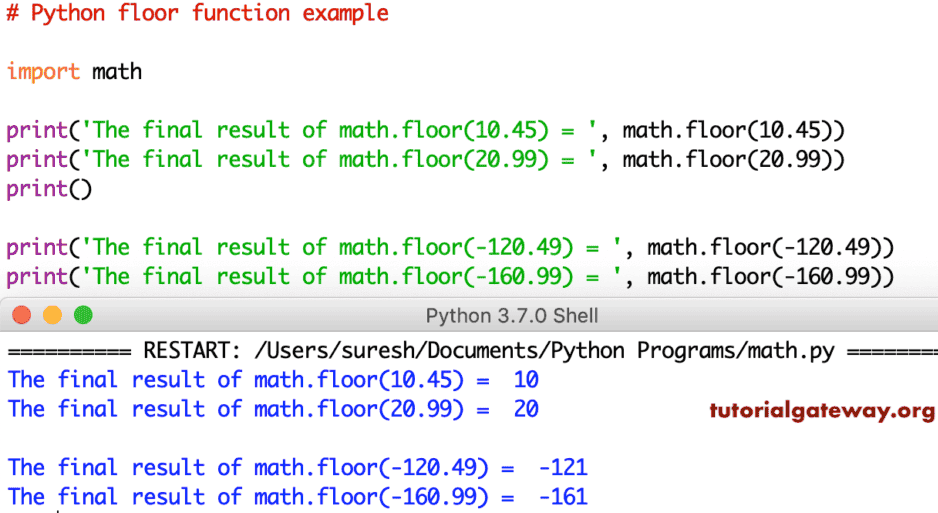Python的math floor函数是math库中可用的数学函数之一。此floor函数用于返回小于或等于指定表达式或值的最接近的整数值。
在本文中,我们将向您展示如何在编程中使用math floor函数,并附带示例以及math库中的语法。
math.floor (Expression)
Python math Floor函数示例
floor函数返回小于或等于给定数值的最接近的整数值。让我向您展示一个返回12.95最接近值的floor函数示例。
import math val = math.floor(12.95) print(val)
12在此floor示例中,它接受参数并返回正值和负值的最小整数值。
import math
print('The final result of math.floor(10.45) = ', math.floor(10.45))
print('The final result of math.floor(20.99) = ', math.floor(20.99))
print()
print('The final result of math.floor(-120.49) = ', math.floor(-120.49))
print('The final result of math.floor(-160.99) = ', math.floor(-160.99))

Python math.floor函数示例
下面的查询将向您展示使用此math floor函数的多种方法。
import math # This allows us to use the floor function
a = 0.24
b = -90.98
c = 45.05
d = 45.98
e = math.floor(2.45 + 7.55 - 14.88)
pi = math.floor(math.pi)
x = [-22.45, 2.40, 9.65] # List Example
y = (-2.45, 22.10, 22.95) # Tuple Example
print(" The Value of 'a' after the floor function is: ", math.floor(a))
print(" The Value of %.2f after the floor function is: %d" %(b, math.floor(b)))
print(" The Value of %.2f after the floor function is: %d" %(c, math.floor(c)))
print(" The Value of %.2f after the floor function is: %d" %(d, math.floor(d)))
print(" The Value of 'e' after the floor function is: ", e)
print(" The Value of 'PI' after the floor function is: ", pi)
print(" ")
# printing List values
print(" First Value from List is: ", math.floor(x[0]))
print(" Second Value from List is: ", math.floor(x[1]))
print(" Third Value from List is: ", math.floor(x[2]))
print(" ")
# printing Tuple values
print(" First Value from List is: ", math.floor(y[0]))
print(" Second Value from List is: ", math.floor(y[1]))
print(" Third Value from List is: ", math.floor(y[2]))
The Value of 'a' after the floor function is: 0
The Value of -90.98 after the floor function is: -91
The Value of 45.05 after the floor function is: 45
The Value of 45.98 after the floor function is: 45
The Value of 'e' after the floor function is: -5
The Value of 'PI' after the floor function is: 3
First Value from List is: -23
Second Value from List is: 2
Third Value from List is: 9
First Value from List is: -3
Second Value from List is: 22
Third Value from List is: 22首先,我们使用以下语句导入了math库。这将使我们能够使用floor等数学函数。
import math
下面的Python代码行用于声明变量并分配值。
a = 0.24 b = -90.98 c = 45.05 d = 45.98
在下一行中,我们直接将math floor函数应用于多个值(一些计算)。
e = math.floor(2.45 + 7.55 - 14.88)
这意味着
floor (2.45 + 7.55 – 14.88)
floor (-4.88) = – 5
在下一行中,我们声明了列表和元组。接下来,我们在print语句中使用floor函数来查找上述变量的最接近整数值。
int和floor之间的区别
这是一个经常被问到的问题,因为int和floor函数对于正值返回相同的结果。但是,如果您使用负值作为参数进行检查,您会发现区别。
import math
print('math.floor(100.45) Result = ', math.floor(100.45))
print('math.floor(200.99) Result = ', math.floor(200.99))
print('int(100.45) Result = ', int(100.45))
print('int(200.99) Result = ', int(200.99))
print()
print('math.floor(-150.49) result = ', math.floor(-150.49))
print('math.floor(-260.99) result = ', math.floor(-260.99))
print('int(-150.49) result = ', int(-150.49))
print('int(-260.99) result = ', int(-260.99))
math.floor(100.45) Result = 100
math.floor(200.99) Result = 200
int(100.45) Result = 100
int(200.99) Result = 200
math.floor(-150.49) result = -151
math.floor(-260.99) result = -261
int(-150.49) result = -150
int(-260.99) result = -260floor除法示例
此数学运算符返回除法的向下取整结果。
# floor Division example a = 10 b = 3 x = a / b print(x) y = a // b print(y)
3.3333333333333335
3列表示例
让我对列表项使用此math floor函数。在这里,我们使用For循环迭代列表项,然后为每个项应用floor函数。
import math numbers = [-10.89, 20.22, 40.67, -350.11, -450.91] for num in numbers: print(math.floor(num))
-11
20
40
-351
-451此Python math.floor函数示例与上面相同。但是,这次我们使用Map和Lambda函数来迭代项目。
import math
numbers = [-10.89, 20.22, 40.67, -350.11, -450.91]
print(numbers)
print()
floor_result = map(lambda num: math.floor(num), numbers)
print('The final result = ', list(floor_result))
[-10.89, 20.22, 40.67, -350.11, -450.91]
The final result = [-11, 20, 40, -351, -451]